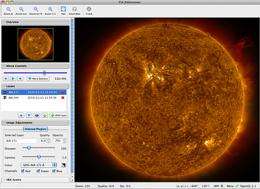ESA makes the Sun available to everyone

(PhysOrg.com) -- New software developed by ESA makes available online to everyone, everywhere at anytime, the entire library of images from the SOHO solar and heliospheric observatory. Just download the viewer and begin exploring the Sun.
JHelioviewer is new visualisation software that enables everyone to explore the Sun. Developed as part of the ESA/NASA Helioviewer Project, it provides a desktop program that enables users to call up images of the Sun from the past 15 years.
More than a million images from SOHO can already be accessed, and new images from NASA’s Solar Dynamics Observatory are being added every day. The downloadable JHelioviewer is complemented by the website Helioviewer.org, a web-based image browser.
Using this new software, users can create their own movies of the Sun, colour the images as they wish, and image-process the movies in real time. They can export their finished movies in various formats, and track features on the Sun by compensating for solar rotation.
“We wanted to make it easy to view solar images from different observatories and instruments, and to make it easy to make movies,” says Daniel Müller, ESA SOHO Deputy Project Scientist. “Before, it took hours to combine images from different telecopes to make a movie of the Sun for a given period. With JHelioviewer, everyone can do this in minutes. This is an interactive visual archive of the entire SOHO mission.”
JHelioviewer is written in the Java programming language, hence the ‘J’ at the beginning of its name. It is open-source software, meaning that all its components are freely available so others can help to improve the program.
The code can even be reused for other purposes; it is already being used for Mars data and in medical research. This is because JHelioviewer does not need to download entire datasets, which can often be huge – it can just choose enough data to stream smoothly over the Internet.
It also allows data to be annotated, say, solar flares of a particular magnitude to be marked or diseased tissues in medical images to be highlighted.
“The goal of JHelioviewer, and the Helioviewer Project as a whole, is to offer intuitive interfaces to large datasets from many different sources. In effect, it is a virtual observatory,” says Müller.
More information: JHelioviewer can be downloaded from here and will work on Mac, PC or Linux machines. A basic handbook to get users started is available here.
Provided by European Space Agency



















